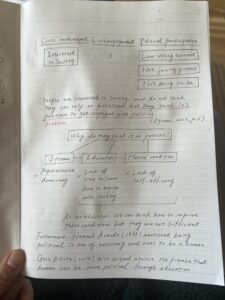In liberal democratic countries, it is said that citizens should consciously engage in social reproduction as members of society. In other words, I understand that one should critically examine the lives and societies that are reproduced unconsciously, raise voices, take action, and create feedback loops to make the country better. Additionally, as the premise, citizens need to be interested in society and politics and actively participate. However, in Japan, this premise is questionable.
Before explaining the situation in Japan in detail, it is necessary to define political participation and civic engagement. Both definitions vary among different people, making it difficult to define them clearly. Here, I will borrow the definitions from Ekman and Amnå (2012), which organizes various past definitions. First, political participation involves directly influencing politicians or political parties, including activities such as voting, participating in demonstrations, signing petitions, and making donations to political parties. Civic engagement, which lead to future political participation, is behaviours that positively impact someone other than oneself in society. This range is broad and includes activities from recycling to volunteering in the community. Additionally, there is civic involvement as a potential state of them, which is an attitude of being interested in politics and society.
Applying the indicators revealing citizen’s behaviours in Japan to the above definitions, the level of political participation is low, considering the declining voter turnout year by year (the latest voter turnout the national election is 55%) and only 1% of participation rate for demonstrations (1%). Regarding civic engagement, the participation number in volunteer activities among adults aged 20 and older is low at 17%.
*It should be noted that Ekman and Amnå (2012) point out that opinion surveys do not include questions to accurately grasp the situation of political participation including potential ones, and in terms of civic engagement, it cannot be fully understood solely based on the visible numbers, due to its multitude of actions included. Nevertheless, it is obvious that there is some level of interest in politics and civic engagement. According to a survey by NHK, 84% of people are interested in society.
From all of the above, we can mostly understand the current citizens’ behaviours that they hesitate to take actions toward society and politics, but they are interested in them.
In surveys investigating the background of political aversion, nihilism is found to be a factor in avoiding involvement in politics. Furthermore, according to a survey by the Asahi newspaper, 67% of respondents answered that ‘participating in politics will not change the world.’ In a youth survey conducted by the Japan Foundation, only 18% of respondents answered that ‘they think they can change the country or society by themselves,’ indicating a lack of self-efficacy toward politics and society.
My research goals are exploring the background of this low efficacy that causes low political and civic engagements, and proposing approaches to improve.
Currently, there seems to be no comprehensive understanding of the background of this low sense of efficacy in the literature and surveys, but there are several hypotheses.
– The social system diminishes the sense of efficacy
– Representative democracy leads to lower political participation rates than direct democracy
– There are problems with education that fosters awareness of politics and society and the necessary knowledge for participation
– Due to experiences of constantly being judged by test results, confidence in one’s own abilities has been eroded
– Politics and society are portrayed as too large to be controlled by individuals.
– There are problems with how society and politics are narrated.
– Media constantly reporting on despairing news, etc.
These are hypotheses, so further research is needed to verify whether these backgrounds exist and to conduct interdisciplinary verification.
– Research Process 1
Verification of hypotheses that are likely to exist as backgrounds for the sense of efficacy (literature review)
On the other hand, the hypotheses are already interdisciplinary, and they are likely to be intertwined. In other words, there is a high possibility that there are no clear problems that reduce efficacy and no clear solutions (Wicked Problem). Therefore, merely verifying the hypotheses may not lead to increasing efficacy. Therefore, it will also be implemented to create prototypes of approaches to increase efficacy based on the consciousness and actions of those who already have a high sense of efficacy and are taking action, even in a society like Japan where efficacy is generally low.
– Research Process 2
Conduct an Open Prototype with people who already have a sense of efficacy toward politics and society and are taking some form of action to increase efficacy
What is Open Prototype: Conceptual and methodological framework that interdisciplinarily connect people and develop tangible future ideas.
Screening before conducting Open Prototype: Select participants who answer ‘yes’ to ‘Do you think you have the power to change society and politics?’ and have answered yes to the question ‘Do you take any actions in your daily life to improve society and politics?’
Through the above processes, I aim to visualize the backgrounds of low efficacy toward politics and society and their relationships, propose approaches that may be effective for the complex intertwined backgrounds, and create prototypes for increasing efficacy.
This research targets will be limited to young people (in their 20s-30s), who are known to have particularly low rates of political participation, civic engagement and sense of efficacy.
